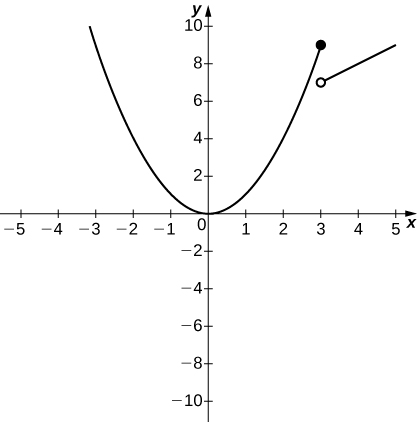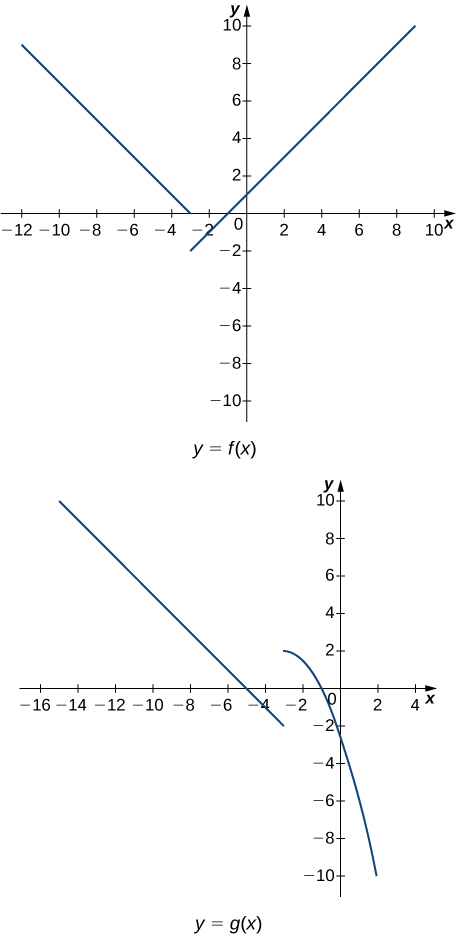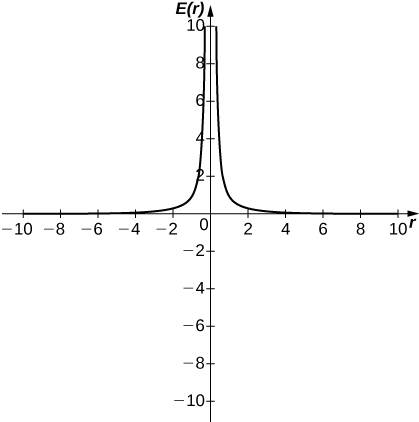1.3E: Exercises
- Page ID
- 10659
This page is a draft and is under active development.
Exercise \(\PageIndex{1}\)
In exercises 1 - 4, use the limit laws to evaluate each limit. Justify each step by indicating the appropriate limit law(s).
1) \(\displaystyle \lim_{x→0}\,(4x^2−2x+3)\)
- Answer
-
Use constant multiple law and difference law:
\(\displaystyle \lim_{x→0}\,(4x^2−2x+3)=4\lim_{x→0}x^2−2\lim_{x→0}x+\lim_{x→0}3=0 + 0 + 3=3\)
2) \(\displaystyle \lim_{x→1}\frac{x^3+3x^2+5}{4−7x}\)
3) \(\displaystyle \lim_{x→−2}\sqrt{x^2−6x+3}\)
- Answer
- Use root law: \(\displaystyle \lim_{x→−2}\sqrt{x^2−6x+3}=\sqrt{\lim_{x→−2}(x^2−6x+3)}=\sqrt{19}\)
4) \(\displaystyle \lim_{x→−1}(9x+1)^2\)
Exercise \(\PageIndex{2}\)
In exercises 1 - 4, use direct substitution to evaluate the limit of each continuous function.
1) \(\displaystyle \lim_{x→7}x^2\)
- Answer
- \(\displaystyle \lim_{x→7}x^2\;=\;49\)
2) \(\displaystyle \lim_{x→−2}(4x^2−1)\)
3) \(\displaystyle \lim_{x→0}\frac{1}{1+\sin x}\)
- Answer
- \(\displaystyle \lim_{x→0}\frac{1}{1+\sin x}\;=\;1\)
4) \(\displaystyle \lim_{x→1}\frac{2−7x}{x+6}\)
- Answer
- \(\displaystyle \lim_{x→1}\frac{2−7x}{x+6}\;=\;−\frac{5}{7}\)
Exercise \(\PageIndex{3}\)
In exercises 1 - 9, use direct substitution to show that each limit leads to the indeterminate form \(0/0\). Then, evaluate the limit analytically.
1) \(\displaystyle \lim_{x→4}\frac{x^2−16}{x−4}\)
- Answer
- \(\displaystyle \lim_{x→4}\frac{x^2−16}{x−4}=\frac{16−16}{4−4}=\frac{0}{0};\)
then, \(\displaystyle \lim_{x→4}\frac{x^2−16}{x−4}= \lim_{x→4}\frac{(x+4)(x−4)}{x−4}=\lim_{x→4}(x+4) = 4+4 =8\)
2) \(\displaystyle \lim_{x→2}\frac{x−2}{x^2−2x}\)
3) \(\displaystyle \lim_{x→6}\frac{3x−18}{2x−12}\)
- Answer
- \(\displaystyle \lim_{x→6}\frac{3x−18}{2x−12}=\frac{18−18}{12−12}=\frac{0}{0};\)
then, \(\displaystyle \lim_{x→6}\frac{3x−18}{2x− 12}=\lim_{x→6}\frac{3(x−6)}{2(x−6)}=\lim_{x→6}\frac{3}{2}=\frac{3}{2}\)
4) \(\displaystyle \lim_{h→0}\frac{(1+h)^2−1}{h}\)
5) \(\displaystyle \lim_{t→9}\frac{t−9}{\sqrt{t}−3}\)
- Answer
- \(\displaystyle \lim_{x→9}\frac{t−9}{\sqrt{t}−3}=\frac{9−9}{3−3}=\frac{0}{0};\)
then, \(\displaystyle \lim_{t→9}\frac{t−9}{\sqrt{t}−3} =\lim_{t→9}\frac{t−9}{\sqrt{t}−3}\frac{\sqrt{t}+3}{\sqrt{t}+3}=\lim_{t→9}\frac{(t−9)(\sqrt{t}+3)}{t - 9}=\lim_{t→9}(\sqrt{t}+3)=\sqrt{9}+3=6\)
6) \(\displaystyle \lim_{h→0}\frac{\dfrac{1}{a+h}−\dfrac{1}{a}}{h}\), where \(a\) is a real-valued constant
7) \(\displaystyle \lim_{x→1}\frac{x^3−1}{x^2−1}\)
8) \(\displaystyle \lim_{x→1/2}\frac{2x^2+3x−2}{2x−1}\)
- Answer
- \(\displaystyle \lim_{x→1/2}\frac{2x^2+3x−2}{2x−1}=\frac{\frac{1}{2}+\frac{3}{2}−2}{1−1}=\frac{0}{0};\)
then, \(\displaystyle \lim_{x→ 1/2}\frac{2x^2+3x−2}{2x−1}=\lim_{x→1/2}\frac{(2x−1)(x+2)}{2x−1}=\lim_{x→1/2}(x+2)=\frac{1}{2}+2=\frac{5}{2}\)
9) \(\displaystyle \lim_{x→−3}\frac{\sqrt{x+4}−1}{x+3}\)
Exercise \(\PageIndex{4}\)
In exercises 1 - 4, use direct substitution to obtain an undefined expression. Then, use the method used in Example 9 of this section to simplify the function and determine the limit.
1) \(\displaystyle \lim_{x→−2^−}\frac{2x^2+7x−4}{x^2+x−2}\)
- Answer
- \(−∞\)
2) \(\displaystyle \lim_{x→−2^+}\frac{2x^2+7x−4}{x^2+x−2}\)
3) \(\displaystyle \lim_{x→1^−}\frac{2x^2+7x−4}{x^2+x−2}\)
- Answer
- \(−∞\)
4) \(\displaystyle \lim_{x→1^+}\frac{2x^2+7x−4}{x^2+x−2}\)
Exercise \(\PageIndex{5}\)
In exercises 1 - 8, assume that \(\displaystyle \lim_{x→6}f(x)=4,\quad \lim_{x→6}g(x)=9\), and \(\displaystyle \lim_{x→6}h(x)=6\). Use these three facts and the limit laws to evaluate each limit.
1) \(\displaystyle \lim_{x→6}2f(x)g(x)\)
- Answer
- \(\displaystyle \lim_{x→6}2f(x)g(x)=2\left(\lim_{x→6}f(x)\right)\left(\lim_{x→6}g(x)\right)=2 (4)(9)=72\)
2) \(\displaystyle \lim_{x→6}\frac{g(x)−1}{f(x)}\)
3) \(\displaystyle \lim_{x→6}\left(f(x)+\frac{1}{3}g(x)\right)\)
- Answer
- \(\displaystyle \lim_{x→6}\left(f(x)+\frac{1}{3}g(x)\right)=\lim_{x→6}f(x)+\frac{1}{3}\lim_{x→6}g(x)=4+\frac{1}{3}(9)=7\)
4) \(\displaystyle \lim_{x→6}\frac{\big(h(x)\big)^3}{2}\)
5) \(\displaystyle \lim_{x→6}\sqrt{g(x)−f(x)}\)
- Answer
- \(\displaystyle \lim_{x→6}\sqrt{g(x)−f(x)}=\sqrt{\lim_{x→6}g(x)−\lim_{x→6}f(x)}=\sqrt{9-4}=\sqrt{5}\)
6) \(\displaystyle \lim_{x→6}x⋅h(x)\)
7) \(\displaystyle \lim_{x→6}[(x+1)⋅f(x)]\)
- Answer
- \(\displaystyle \lim_{x→6}[(x+1)f(x)]=\left(\lim_{x→6}(x+1)\right)\left(\lim_{x→6}f(x)\right)=7(4)=28\)
8) \(\displaystyle \lim_{x→6}(f(x)⋅g(x)−h(x))\)
Exercise \(\PageIndex{6}\)
[T] In exercises 1 - 3, use a calculator to draw the graph of each piecewise-defined function and study the graph to evaluate the given limits.
1) \(f(x)=\begin{cases}x^2, & x≤3\\ x+4, & x>3\end{cases}\)
a. \(\displaystyle \lim_{x→3^−}f(x)\)
b. \(\displaystyle \lim_{x→3^+}f(x)\)
- Answer
-

a. \(9\); b.\( 7\)
1) \(g(x)=\begin{cases}x^3−1, & x≤0\\1, & x>0\end{cases}\)
a. \(\displaystyle \lim_{x→0^−}g(x)\)
b. \(\displaystyle \lim_{x→0^+}g(x)\)
3) \(h(x)=\begin{cases}x^2−2x+1, & x<2\\3−x, & x≥2\end{cases}\)
a. \(\displaystyle \lim_{x→2^−}h(x)\)
b. \(\displaystyle \lim_{x→2^+}h(x)\)
Exercise \(\PageIndex{7}\)
In exercises 1 - 8, use the following graphs and the limit laws to evaluate each limit.

1) \(\displaystyle \lim_{x→−3^+}(f(x)+g(x))\)
2) \(\displaystyle \lim_{x→−3^−}(f(x)−3g(x))\)
- Answer
- \(\displaystyle \lim_{x→−3^−}(f(x)−3g(x))=\lim_{x→−3^−}f(x)−3\lim_{x→−3^−}g(x)=0+6=6\)
3) \(\displaystyle \lim_{x→0}\frac{f(x)g(x)}{3}\)
4) \(\displaystyle \lim_{x→−5}\frac{2+g(x)}{f(x)}\)
- Answer
- \(\displaystyle \lim_{x→−5}\frac{2+g(x)}{f(x)}=\frac{2+\left(\displaystyle \lim_{x→−5}g(x)\right)}{\displaystyle \lim_{x→−5}f(x)}=\frac{2+0}{2}=1\)
5) \(\displaystyle \lim_{x→1}(f(x))^2\)
6) \(\displaystyle \lim_{x→1}\sqrt{f(x)−g(x)}\)
- Answer
- \(\displaystyle \lim_{x→1}\sqrt[3]{f(x)−g(x)}=\sqrt[3]{\lim_{x→1}f(x)−\lim_{x→1}g(x)}=\sqrt[3]{2+5}=\sqrt[3]{7}\)
7) \(\displaystyle \lim_{x→−7}(x⋅g(x))\)
8) \(\displaystyle \lim_{x→−9}[x⋅f(x)+2⋅g(x)]\)
- Answer
- \(\displaystyle \lim_{x→−9}(xf(x)+2g(x))=\left(\lim_{x→−9}x\right)\left(\lim_{x→−9}f(x)\right)+2\lim_{x→−9}g(x)=(−9)(6)+2(4)=−46\)
Exercise \(\PageIndex{8}\)
1) [T] In physics, the magnitude of an electric field generated by a point charge at a distance \(r\) in a vacuum is governed by Coulomb’s law: \(E(r)=\dfrac{q}{4πε_0r^2}\), where \(E\) represents the magnitude of the electric field, \(q\) is the charge of the particle, \(r\) is the distance between the particle and where the strength of the field is measured, and \(\dfrac{1}{4πε_0}\) is Coulomb’s constant: \(8.988×109N⋅m^2/C^2\).
a. Use a graphing calculator to graph \(E(r)\) given that the charge of the particle is \(q=10^{−10}\).
b. Evaluate \(\displaystyle \lim_{r→0^+}E(r)\). What is the physical meaning of this quantity? Is it physically relevant? Why are you evaluating from the right?
- Answer
-
a.

b. ∞. The magnitude of the electric field as you approach the particle q becomes infinite. It does not make physical sense to evaluate the negative distance.
2) [T] The density of an object is given by its mass divided by its volume: \(ρ=m/V.\)
a. Use a calculator to plot the volume as a function of density \((V=m/ρ)\), assuming you are examining something of mass \(8\) kg (\(m=8\)).
b. Evaluate \(\displaystyle \lim_{x→0^+}V(\rho)\) and explain the physical meaning.
Exercise \(\PageIndex{9}\)
Evaluate the following:
- \(\displaystyle \lim\limits_{x\to3}x^2-3x+7\)
- \(\displaystyle \lim\limits_{x\to\pi}\left ( \frac{x-3}{x+5}\right )^7\)
- \(\displaystyle \lim\limits_{x\to3}4^{{x^3}-8x}\)
- \(\displaystyle \lim\limits_{x\to0}\ln (1+x)\)
- \(\displaystyle \lim\limits_{x\to\pi}\frac{x^2+3x+5}{5x^2-2x-3}\)
- \(\displaystyle \lim\limits_{x\to\pi}\frac{3x+1}{1-x}\)
- \(\displaystyle \lim\limits_{x\to6}\frac{x^2-4x-12}{x^2-13x+42}\)
- \(\displaystyle \lim\limits_{x\to0}\frac{x^2+2x}{x^2-2x}\)
- \(\displaystyle \lim\limits_{x\to2}\frac{x^2+6x-16}{x^2-3x+2}\)
- \(\displaystyle \lim\limits_{x\to2}\frac{x^2-5x-14}{x^2+10x+16}\)
- \(\displaystyle \lim\limits_{x\to-2}\frac{x^2-5x-14}{x^2+10x+16}\)
- \(\displaystyle \lim\limits_{x\to-1}\frac{x^2+9x+8}{x^2-6x-7}\)
- Answer
-
Under Construction
Exercise \(\PageIndex{10}\)
\( \displaystyle \lim_{x \to 0} \frac{\sqrt{x+4}-2}{x}\)
- Answer
-
\( \displaystyle \lim_{x \to 0} \frac{\sqrt{x+4}-2}{x} = \frac{\sqrt{0+4}-2}{0} =\left[\frac{0}{0}\right]\)
= \( \displaystyle \lim_{x \to 0} \frac{(\sqrt{x+4}-2) (\sqrt{x+4}+2)}{x (\sqrt{x+4}+2)}\)
= \( \displaystyle \lim_{x \to 0} \frac{((x+4)-4) }{x (\sqrt{x+4}+2)}\)
= \( \displaystyle \lim_{x \to 0} \frac{x }{x (\sqrt{x+4}+2)}\)
= \( \displaystyle \lim_{x \to 0} \frac{1 }{(\sqrt{x+4}+2)}= \frac{1 }{(\sqrt{0+4}+2)}= \frac{1 }{4}\).
Exercise \(\PageIndex{11}\)
Evaluate the following limits:
1. \(\displaystyle \lim\limits_{x\to4}\frac{1}{|4-x|}\)
- Answer
-
\(\displaystyle \infty\)
2. \(\displaystyle \lim\limits_{x\to-1^-}\sqrt{1-x^2}\)
- Answer
-
DNE
3. \(\displaystyle \lim\limits_{x\to-1^+}\sqrt{1-x^2}\)
- Answer
-
0
4. \(\displaystyle \lim\limits_{x\to2}\frac{|x-2|}{x^2+x-6}\)
- Answer
-
\(\displaystyle \mbox{dne}\)
5. \(\displaystyle \lim\limits_{x\to2}\frac{\frac{1}{x}-\frac{1}{2}}{x-2}\)
- Answer
-
\(\displaystyle \frac{1}{4}\)
6. \(\displaystyle f(x)=\begin{cases} x^2 & \mbox{if } x \leq 1 \\ 2x & \mbox{if } x > 1\end{cases}\)
- Answer
-
Under Construction
Contributors and Attributions
Gilbert Strang (MIT) and Edwin “Jed” Herman (Harvey Mudd) with many contributing authors. This content by OpenStax is licensed with a CC-BY-SA-NC 4.0 license. Download for free at http://cnx.org.
Gregory Hartman (Virginia Military Institute). Contributions were made by Troy Siemers and Dimplekumar Chalishajar of VMI and Brian Heinold of Mount Saint Mary's University. This content is copyrighted by a Creative Commons Attribution - Noncommercial (BY-NC) License. http://www.apexcalculus.com/
Pamini Thangarajah (Mount Royal University, Calgary, Alberta, Canada)

